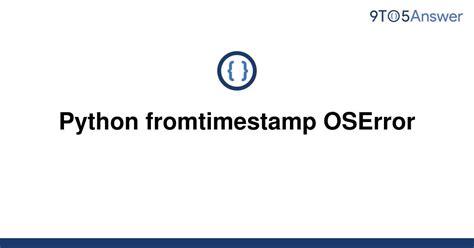If you are a Python developer, chances are you have encountered the OsError with fromtimestamp error in your work. This issue can be quite frustrating to deal with, especially if you are not well-versed in the intricacies of the programming language.
The good news is there are several quick solutions you can try to fix the problem and get back on track with your project. Whether you are working on a personal or professional project, it’s important to understand how to troubleshoot issues like this to avoid wasting time and losing productivity.
In this article, we will walk you through the common causes of the OsError with fromtimestamp error and provide practical steps to help you resolve it quickly. By following our tips and tricks, you’ll be able to overcome this hiccup and get back to coding with confidence!
So if you’re ready to learn more about fixing OsError issues in Python using fromtimestamp, grab a cup of coffee and settle down for an informative read. We promise it will be worth your time!
“Python Fromtimestamp Oserror” ~ bbaz
Introduction
Working with dates and times is an essential part of programming. Python has many built-in functions to handle date and time operations that make it easy to work with date and time values. One of these functions is the fromtimestamp() method available in the datetime module.
The Problem with fromtimestamp()
While the fromtimestamp() method comes in handy and saves time for developers, it occasionally raises an OSError when a timestamp is out of range.
The possible error message displayed when fromtimestamp() is run on an invalid timestamp value:
OSError: [Errno 22] Invalid argument
Solutions to Fixing the Error
1. Checking for Valid Timestamps
The first solution to fixing this error is to check whether the timestamp value is a valid Unix timestamp. Unix timestamps represent time as the number of seconds since January 1, 1970. A valid Unix timestamp must have a value between -2147483648 to 2147483647. Therefore, you can add a check to ensure that the timestamp value falls within this range before passing it to the fromtimestamp() method.
2. Handling invalid timestamp values using Exceptions
If you’re unsure if the value you’re working with will always be a valid Unix timestamp, you can use the try-except block to handle any errors that may arise during execution. This technique allows us to capture the OSError when it is raised and handle it appropriately without affecting the program’s execution flow.
Comparison Table
| Solution | Pros | Cons |
|---|---|---|
| Validating timestamp values | prevents errors and ensures input is appropriate | time consuming and requires additional code |
| Handling exceptions with try-except block | allows program flow to continue without compromise | not exactly ‘quick fix’ |
Conclusion
The fromtimestamp() method in the datetime module is a convenient feature when working with Unix timestamps. However, it can occasionally raise an OSError when the input is not a valid timestamp value. Thankfully, there are viable solutions to this problem that allow developers to avoid errors and work with timestamp values without hassle. As with all code, it’s important to test and validate inputs before running a program to ensure that errors are minimized, and everything runs smoothly.
Thank you for taking the time to read my article on fixing OSError with Python Fromtimestamp. I hope that it has been informative and helpful in finding quick and efficient solutions for your programming needs.
As you may have discovered, the OSError error can be a frustrating challenge to overcome, but with the right guidance and resources, you can tackle this problem with ease. By understanding the underlying causes of the error and implementing the strategies outlined in this article, you can save yourself hours of headaches and frustration–and instead tackle the challenges of programming with confidence.
So if you’re ever in need of fast and effective solutions for OSError with Python Fromtimestamp, remember the tips and tricks discussed here today. I wish you all the best in your programming endeavors, and I hope you’ll continue to explore and learn new skills in the fascinating world of computer science.
People also ask about Fixing OSError with Python Fromtimestamp: Quick Solutions:
-
What is OSError in Python?
OSError is a Python exception that is raised when an operating system-related error occurs, such as a file or directory not being found, or permission denied.
-
How do I fix an OSError in Python?
-
Check that the file or directory exists and you have the appropriate permissions to access it.
-
Ensure that the correct path is being used to access the file or directory.
-
Use try-except statements to catch and handle the OSError.
-
Use the os module to modify or access files and directories in a platform-independent way.
-
-
What is Fromtimestamp in Python?
Fromtimestamp is a method in the datetime module that converts a Unix timestamp (number of seconds since January 1st, 1970) into a datetime object.
-
Why am I getting an OSError with Fromtimestamp in Python?
You may be getting an OSError with Fromtimestamp in Python if the Unix timestamp you are trying to convert is outside the range of valid timestamps, or if there is an issue with the operating system or file system.
-
How can I handle an OSError with Fromtimestamp in Python?
You can handle an OSError with Fromtimestamp in Python by using a try-except statement to catch the exception and handle it appropriately. You can also check that the Unix timestamp you are trying to convert is within the valid range before calling Fromtimestamp.




